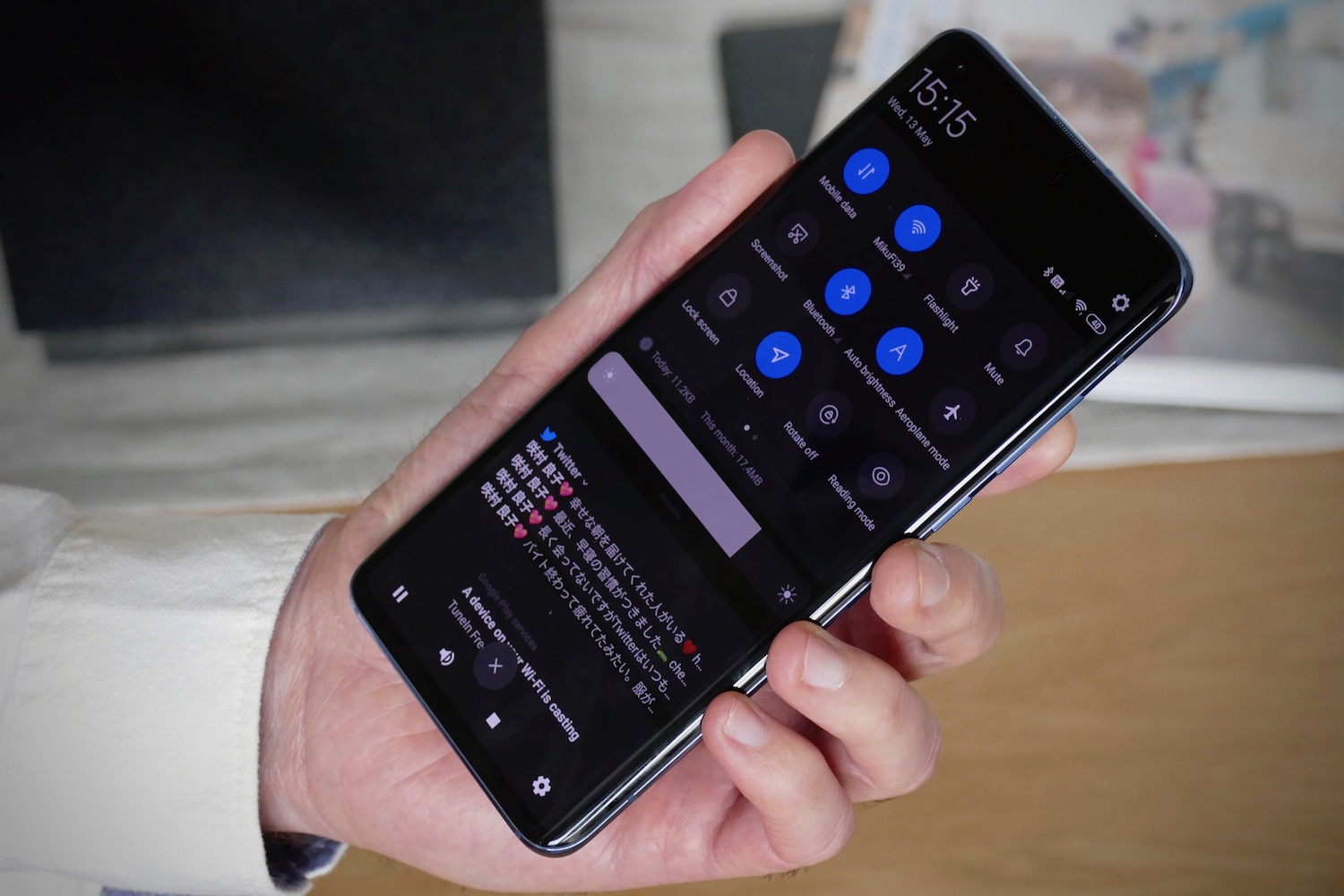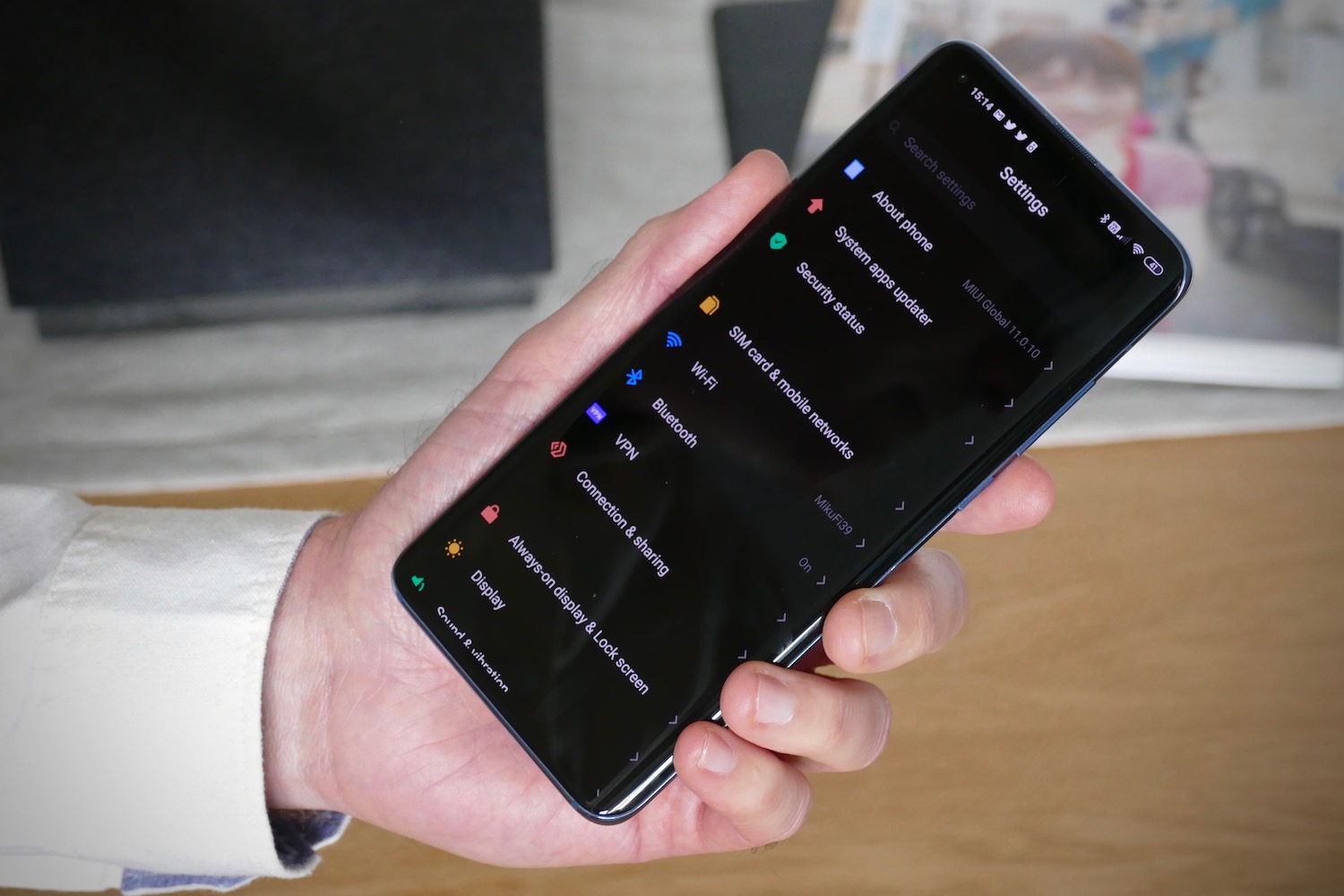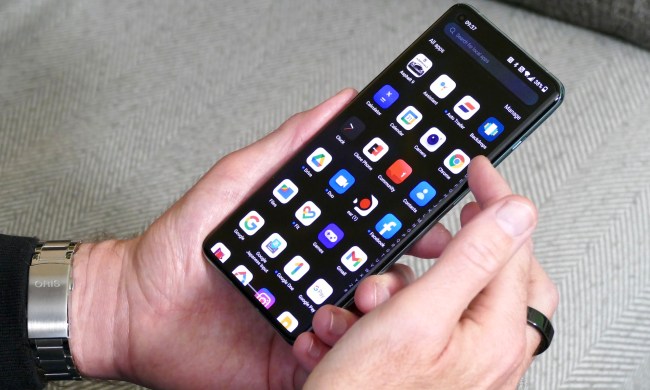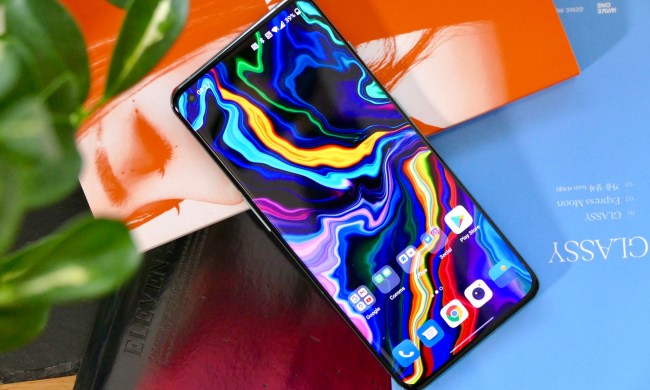“The Xiaomi Mi 10 Pro impresses, but isn't without frustration, and its high price ensures tough competition.”
- Colorful, detailed screen
- Excellent audio
- Very long-lasting battery
- Capable, fun camera
- Unreliable software
- Overly sensitive screen edges
Xiaomi is best-known for its reasonably priced, high-spec smartphones. The new Xiaomi Mi 10 Pro doesn’t quite fit that description. It is a high-spec flagship, but it costs 1,000 euros, or $1,080 U.S. That’s nearly twice the price of the Mi 9 from last year.
While we can’t change the price, we can decide whether it’s justified. I’ve been using the Mi 10 Pro for a couple of weeks to see if it’s worth the four-figure price tag. Did Xiaomi really have to follow the trend of making desirable smartphones expensive?
Design
The Xiaomi Mi 10 Pro is a mature, rather than showy, phone. I hesitate to call it stealthy because it’s also a big, old bruiser of a device, and certainly won’t shrink into the background. It is a pretty phone, mostly due to the use of frosted glass on the back, which adds a modern, classy style that I also really liked about the Huawei P40 Pro. Colors on my solstice gray review model subtly shift between blue, gray, and silver. It’s nowhere near as vibrant or eye-catching as the OnePlus 8 Pro, for example.

Made from glass and aluminum, the Mi 10 Pro is heavy. It’s 208 grams, and the weight is slightly biased toward the top of the phone, presumably due to the massive array of camera lenses on the back. Set to the left, the camera module sticks out by a good few millimeters, so it doesn’t rest flat on any surface. Combine this with the slippery glass, and the phone refuses to stay still when I place it on a table or the couch. It has fallen off things more than any other phone I’ve used recently.
The aluminum chassis doesn’t sit flush with the glass rear panel, either, meaning you can feel a ridge when gripping the phone, something you have to do quite tightly because of its 9mm thick body. It’s not as comfortable to hold as the OnePlus 8 Pro, or the Huawei P40 Pro. It’s well-made, though, and feels very solid. Even after its various falls, it has not sustained any major damage.

If you’re expecting the Mi 10 Pro’s design and materials to be reasons for the higher-than-usual price, they’re not. The Mi 10 Pro is what we’d expect from any flagship phone today, and is no different from any other top Mi device. This means it’s attractive without being over the top, the build quality is great, and you’ll be proud to put it down on the table.
It’ll slide about when you do, but it’ll get some admiring glances at the same time.
Screen
The Mi 10 Pro’s screen is exactly what we want in 2020. It’s a 6.67-inch Super AMOLED panel with a 90Hz refresh rate and a 2340 x 1080 pixel resolution. While this is lower than the Samsung Galaxy S20 Plus, it’s perfectly adequate, and keeps power consumption in check too. I struggle to see the difference between 90Hz and a 120Hz refresh rate, so having the 90Hz rate here is absolutely fine.

The screen is bright, and the AMOLED panel does what you’d expect by returning plenty of contrast, with deep blacks and some vivid colors. I love the balance here –it avoids too much saturation while keeping things lively. The level of detail is also spot-on, and watching video is lovely, thanks in part to the decent stereo speakers. Placed at the top and bottom of the phone for maximum channel separation effect, what they lack in bass, they make up for in overall volume.
A small hole-punch selfie camera is in the top corner, and you quickly get used to it being there, to the point where it effectively disappears. Zoom in on YouTube videos, and you eliminate the black borders down either side of the screen, but lose a little of the picture at the top and bottom.
The Grand Tour on Amazon Prime emphasizes the dynamic visuals, and because of the quality audio, I could happily sit down and watch an entire episode without wanting to swap to a tablet or TV.

There is one big problem: Edge recognition, and the resulting numerous phantom touches. A software update has improved this during my review, but it’s still not perfect. I’m forever opening the Telephone app accidentally, and have made at least one unintended call too.
While on a call, my cheek has activated the Mute feature, so the person I was calling suddenly stopped hearing me. Add the times I’d swipe screens or close apps with my palm, along with the slipperiness of the phone itself, and the Mi 10 Pro can be a little frustrating.
Aside from this, the Mi 10 Pro provides an outstanding visual experience, and one that’s worth splurging on.
Camera
The Mi 10 Pro has a 108-megapixel main sensor, the one it co-developed with Samsung, and likely almost identical to the one on the Samsung Galaxy S20 Ultra. The 1/1.33-inch sensor has an f/1.69 aperture and optical image stabilization, plus it’s joined by three additional sensors. There’s a 20-megapixel wide-angle lens, a 12-megapixel portrait sensor, and an 8-megapixel zoom lens. The selfie camera has 20-megapixels.

There’s one word to describe the majority of shots taken on a sunny day with the Mi 10 Pro: Intense. If you aren’t a fan of high levels of saturation, look away now, because the Mi 10 Pro doesn’t shy away from amping up the blues, greens, and reds. The HDR is also strong, bringing out detail in overcast skies and balancing the surroundings with it nicely. It’s not the most natural camera out there, but if you want photos you share to really catch the eye, it’s tuned in exactly the right fashion.
Dig into the camera app and there are plenty of features to try. It can shoot 108-megapixel photos, which aren’t as saturated as those taken with the standard camera and can be cropped without losing detail. I like the way you can switch from macro mode to wide, standard, 2x, and 5x zoom in the viewfinder, without searching for the macro mode setting, as is the case with other cameras. The big sensor provides a lovely, natural bokeh effect too.
The zoom is decent, although there are considerable dynamic and exposure differences when you get to 5x zoom. The real test of the software comes at the 50x digital maximum. At this level, it can’t come close to the Huawei P40 Pro, which outshines it in detail and clarity and also boasts a considerably steadier viewfinder. Outside of this, the zoom takes good photos, and along with the wide-angle, adds significant fun to the camera.
I like some of the software and modes as well. Xiaomi’s filters are especially interesting. The Sky filter actually changes cloudy skies to bright sunny skies, and it works in an uncannily effective way. The app itself is well laid-out and speedy to use, but it is quite complex, with lots of features to keep track of. The Gallery has a photo editor, but it’s not as packed as the Huawei or Apple app, or as effective as using an app like Snapseed.
- 1. Standard unfiltered photo taken with the Mi 10 Pro
- 2. Sky Filter added to Mi 10 Pro photo
Finally, the selfie camera takes good portrait shots with strong edge detection, but watch out for the skin smoothing, which seems to always be active whether the beauty mode is on or not. I’ve enjoyed using the Mi 10 Pro’s camera a great deal, and find the shots are instantly shareable without much editing. It’s not as wonderfully nuanced or as outrageously capable as the P40 Pro, but it will appeal to those who want a camera for Instagram.
Software and connectivity
Xiaomi has its own version of Android 10 installed — it’s called MIUI, and this is version 11. Some may dislike the way it forces you to place apps across multiple home screens, like Apple’s iOS. It is indeed frustrating — doubly so because you have to enable the swipe-up-to-search feature in Settings or otherwise end up staring at screens full of app icons, not finding what you want.
This is just the first aspect that will be different for those coming from a non-MIUI phone. The Settings menu is laid out differently, animations aren’t quite so smooth as say, Samsung’s OneUI 2.0, and the helicopter view of open apps provides a different, vertical list of cards, along with some quick-launch links. There are plenty of customization options, and I like the way you can choose how the always-on display looks. If you spend time getting it all looking and feeling right, MIUI becomes perfectly acceptable.
However, I have experienced more problems here than on previous Xiaomi phones. Notifications are unreliable, and I have missed various messages through the Line app. I have had the phone connected to a WearOS smartwatch too, and it needed a restart each day to reconnect with it and deliver notifications. More startlingly, the phone would also freak out sometimes, going into a vibration loop and refusing to exit apps when it happened. On the more positive side, calls were excellent and very clear, although due to movement restrictions, I have not been able to test 5G.

Ah, 5G. Now we get to why the Mi 10 Pro’s price has increased. This is the only major new feature we have not seen on a flagship Xiaomi phone before, and it’s a costly addition. It’s also not a reason to buy the Mi 10 Pro. Currently, 5G may not be available in your local area, making it a feature for the future, and of questionable value today.
MIUI can be frustrating, especially when you don’t trust it to deliver notifications, but it’s always improving and Xiaomi does release regular updates for the platform. The software is probably the biggest downside to the Mi 10 Pro, mostly due to its unreliability.
Performance and battery
The Mi 10 Pro has a Qualcomm Snapdragon 865 chipset and 5G modem, with 8GB of RAM and 256GB of UFS3.0 internal storage space. It has a single SIM tray, and no room for a MicroSD card. The battery has a massive 4,500mAh capacity, with 50W fast charging and up to 30W wireless charging. Here are the results from two benchmark apps:
Geekbench 5: 908 Single-Core/3,168 Multi-Core
3DMark: 6,422 (Vulkan)
These scores are roughly the same as we’ve seen from the OnePlus 8 Pro, the Samsung Galaxy S20 Plus, and the Oppo Find X2 Pro, all of which have the same processor. I played Asphalt 9 Legends for some time on the Mi 10 Pro, and the game never faltered,and the audio really made it an exciting experience. The phone doesn’t get hot either, due to a multilayer cooling system inside.

Although there are phones with larger batteries available, the Mi 10 Pro makes great use of its 4,500mAh cell. With moderate use, I’ve got two days from it, without even turning it off overnight, although adding a long video call (which is common at the moment) and a few short voice calls caused it to finish the day with less than 10% power remaining.
Price, warranty, and availability
The Xiaomi Mi 10 Pro costs 1,000 euros, or about $1,080, and launched globally in mid-April. Availability is still limited, with the phone being sold in China and a few other locations around the world. A U.K. release has not been confirmed, although it’s entirely possible the phone will launch in Europe. For U.S. buyers, the only option is to import the phone.
Where you purchase it from will affect the warranty. Most reputable online import stores offer a warranty, but it may require sending it back to be repaired.
Our take
The Xiaomi Mi 10 Pro frustrates me. Everything I want is there, with Xiaomi wisely adopting key 2020 trends, from the 90Hz refresh rate to the versatile camera. But the software isn’t as good as it should be, especially for the price. Finally, the inclusion of 5G is (at the moment) a nod toward the future rather than something most can take advantage of today. Taken in isolation, most of these are only minor problems, but pair them with a $1,000-plus price and the availability of better devices and things get dicier. I’ve been happy enough using the Mi 10 Pro, but I’ve never felt like I want to continue ad infinitum, and that’s the frustration — it’s good, but not quite good enough to command this price.
Is there a better alternative?
Yes. We recommend the $1,000 Apple iPhone 11 Pro, the $1,100 Samsung Galaxy S20 Plus, and the $900 OnePlus 8 Pro. Those in the U.K. should also look at the Oppo Find X2 Pro (1,100 British pounds). All these phones have superb cameras, screens, performance, and battery life.
How long will it last?
The Mi 10 Pro is built well and, as mentioned, it has survived a few falls. It also has an IP68 water-resistance rating, so it’s a relatively durable smartphone. With 5G and the most up-to-date processor inside, the phone will last for many years before it’s considered “old,” but the software may become outdated before that time. Xiaomi is good at updating MIUI, but less so with advancing to any new version of Android.
Should you buy it?
No, at least until Xiaomi updates the software to make it more reliable. While its other big features are excellent, the price puts it alongside some very stiff competition, all of which don’t suffer from the same software annoyances.



















